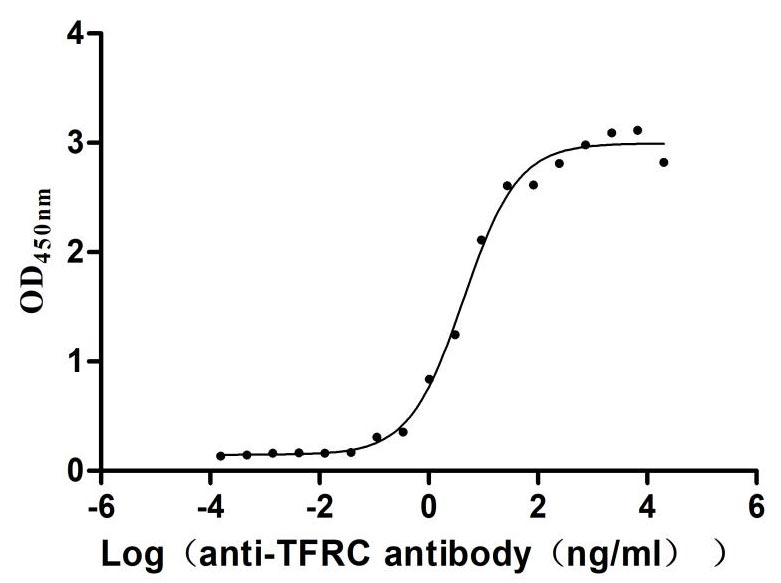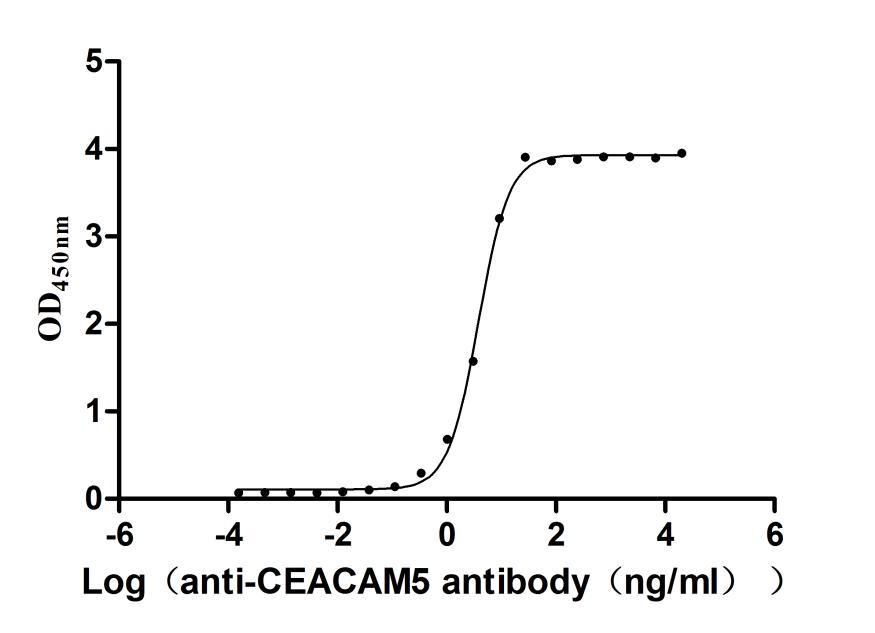Recombinant Human Carbohydrate sulfotransferase 6 (CHST6), partial
-
中文名称:Recombinant Human Carbohydrate sulfotransferase 6(CHST6),partial,Yeast
-
货号:CSB-YP884425HU
-
规格:
-
来源:Yeast
-
其他:
-
中文名称:Recombinant Human Carbohydrate sulfotransferase 6(CHST6),partial,Yeast
-
货号:CSB-EP884425HU
-
规格:
-
来源:E.coli
-
其他:
-
中文名称:Recombinant Human Carbohydrate sulfotransferase 6(CHST6),partial,Yeast
-
货号:CSB-EP884425HU-B
-
规格:
-
来源:E.coli
-
共轭:Avi-tag Biotinylated
E. coli biotin ligase (BirA) is highly specific in covalently attaching biotin to the 15 amino acid AviTag peptide. This recombinant protein was biotinylated in vivo by AviTag-BirA technology, which method is BriA catalyzes amide linkage between the biotin and the specific lysine of the AviTag.
-
其他:
-
中文名称:Recombinant Human Carbohydrate sulfotransferase 6(CHST6),partial,Yeast
-
货号:CSB-BP884425HU
-
规格:
-
来源:Baculovirus
-
其他:
-
中文名称:Recombinant Human Carbohydrate sulfotransferase 6(CHST6),partial,Yeast
-
货号:CSB-MP884425HU
-
规格:
-
来源:Mammalian cell
-
其他:
产品详情
-
纯度:>85% (SDS-PAGE)
-
基因名:CHST6
-
Uniprot No.:
-
别名:C GlcNAc6ST; C-GlcNAc6ST; Carbohydate sulfotransferase 6; Carbohydrate (N acetylglucosamine 6 O) sulfotransferase 6; Carbohydrate sulfotransferase 6; CHST6; CHST6_HUMAN; Corneal GlcNAc6-sulfotransferase; Corneal N acetylglucosamine 6 sulfotransferase; Corneal N-acetylglucosamine-6-O-sulfotransferase; Galactose N acetylglucosamine N acetylglucosamine 6 O sulfotransferase 4 beta; Galactose/N-acetylglucosamine/N-acetylglucosamine 6-O-sulfotransferase 4-beta; GlcNAc6ST 5; GlcNAc6ST-5; Gn6st-5; GST4 beta; GST4-beta; hCGn6ST; N-acetylglucosamine 6-O-sulfotransferase 5
-
种属:Homo sapiens (Human)
-
蛋白长度:Partial
-
蛋白标签:Tag type will be determined during the manufacturing process.
The tag type will be determined during production process. If you have specified tag type, please tell us and we will develop the specified tag preferentially. -
产品提供形式:Lyophilized powder
Note: We will preferentially ship the format that we have in stock, however, if you have any special requirement for the format, please remark your requirement when placing the order, we will prepare according to your demand. -
复溶:We recommend that this vial be briefly centrifuged prior to opening to bring the contents to the bottom. Please reconstitute protein in deionized sterile water to a concentration of 0.1-1.0 mg/mL.We recommend to add 5-50% of glycerol (final concentration) and aliquot for long-term storage at -20℃/-80℃. Our default final concentration of glycerol is 50%. Customers could use it as reference.
-
储存条件:Store at -20°C/-80°C upon receipt, aliquoting is necessary for mutiple use. Avoid repeated freeze-thaw cycles.
-
保质期:The shelf life is related to many factors, storage state, buffer ingredients, storage temperature and the stability of the protein itself.
Generally, the shelf life of liquid form is 6 months at -20°C/-80°C. The shelf life of lyophilized form is 12 months at -20°C/-80°C. -
货期:Delivery time may differ from different purchasing way or location, please kindly consult your local distributors for specific delivery time.Note: All of our proteins are default shipped with normal blue ice packs, if you request to ship with dry ice, please communicate with us in advance and extra fees will be charged.
-
注意事项:Repeated freezing and thawing is not recommended. Store working aliquots at 4°C for up to one week.
-
Datasheet :Please contact us to get it.
相关产品
靶点详情
-
功能:Sulfotransferase that utilizes 3'-phospho-5'-adenylyl sulfate (PAPS) as sulfonate donor to catalyze the transfer of sulfate to position 6 of non-reducing N-acetylglucosamine (GlcNAc) residues of keratan. Cooperates with B4GALT4 galactosyltransferase and B3GNT7 N-acetylglucosaminyltransferase to construct and elongate the sulfated disaccharide unit [->3Galbeta1->4(6-sulfoGlcNAcbeta)1->] within keratan sulfate polymer. Involved in biosynthesis of keratan sulfate in cornea, with an impact on proteoglycan fibril organization and corneal transparency. Involved in sulfation of endothelial mucins such as GLYCAM1.
-
基因功能参考文献:
- This is the first molecular analysis of TGFBI and CHST6 in Turkish patients with different types of corneal dystrophies. PMID: 27829782
- E71Q mutation results in a non-conservative amino acid change in a highly conserved functional domain of the human CHST6 that is essential for enzyme activity as the cause of Macular corneal dystrophy. PMID: 27439461
- Three novel and six previously reported disease-causing CHST6 mutations were identified in Korean patients with macular corneal dystrophy. PMID: 26604660
- Homozygous or compound heterozygous CHST6 mutations were identified in all cases, including two novel mutations, c.13C>T; p.(Arg5Cys) and c.289C>T; p.(Arg97Cys). PMID: 25081284
- This novel gene mutation expands the mutation spectrum of the CHST6 gene and contributes to the study of molecular pathogenesis of corneal dystrophy. PMID: 24311932
- Genetic mutation heterogeneity was revealed. No phenotype heterogeneity was revealed among patients with in vivo corneal morphology assessment or histological analysis. PMID: 24926691
- This study improves the knowledge of the genetic features of Mexican patients with corneal stromal dystrophies by identifying mutations in the TGFBI, CHST6, and GSN genes. PMID: 24801599
- Macular corneal dystrophy (MCD) may result from other changes in the regulatory elements of CHST6 or from genetic heterogeneity. PMID: 22261655
- analysis of pathogenic mutations of TGFBI and CHST6 genes in Chinese patients with Avellino, lattice, and macular corneal dystrophies PMID: 21887843
- CHST6 gene sequencing revealed 2 heterozygous mutations in case 1, a p.Arg211Gln and a novel mutation of p.Arg177Gly and a novel homozygous mutation of p.Pro186Arg in case 2. PMID: 21242781
- CHST6 mutations may be responsible for the pathogenesis of macular corneal dystrophy (MCD) in Chinese patients. PMID: 20539220
- Novel mutations are thought to result in loss of corneal sulfotransferase function. PMID: 11818380
- patients with MCD (macular corneal dystrophy) combined with those reported in previous studies indicated CHST6 mutational heterogeneity. PMID: 12824236
- Two mutations (homozygoous R211W and compound heterozygous R211W/A217T) should be subclassified immunohistochemically into new phenotypes of macular corneal dystrophy. PMID: 12882769
- Mutations identified in the CHST6 gene cosegregated with the disease phenotype in all but one family studied and thus caused macular corneal dystrophy. PMID: 12882775
- novel frameshift and compound heterozygous mutations might be responsible for macular corneal dystrophy PMID: 12883341
- Mutations in the coding region of the CHST6 gene are associated with type I MCD (macular corneal dystrophy) in a cohort of patients in southern India. PMID: 14609920
- We identified 22 (5 nonsense, 5 frameshift, 2 insertion, and 10 missense) mutations in 36 patients from 31 families with MCD (macular corneal dystrophy) PMID: 14735064
- mutations in the coding region of the CHST6 gene are associated with type I macular corneal dystrophy in a cohort of patients from the United States. PMID: 15013869
- the stem region of GlcNAc6ST-1 influences substrate specificity, independent of its role in dimerization or Golgi retention. PMID: 15220337
- These novel mutations are expected to result in loss of CHST6 function, which would account for the MCD (macular corneal dystrophy) phenotype. PMID: 15652851
- These findings indicate that the predicted protein that is encoded by CHST6 is more severely affected in the individual with MCD type I than in the siblings with MCD type II. PMID: 15953452
- Twenty-six different mutations of the CHST6 gene in macular corneal dystrophy in India were identified, of which 14 mutations are novel. PMID: 16207214
- CHST6 mutations are cardinal to the pathogenesis of macular corneal dystrophy(MCD). MCD may result from other subtle changes in CHST6 or from genetic heterogeneity. PMID: 16568029
- Homozygous p.A128V mutation in CHST6 gene and compound heterozygote for p.A128V and frameshift p.V6fs resulting from 10-base pair insertion in macular corneal dystrophy(MCD)I. Compound heterozygotes for p.A128V and p.V329L in MCD II. PMID: 17093400
- In vivo laser confocal microscopy is capable of high-resolution visualization of characteristic corneal microstructural changes related to 3 types of genetically mapped corneal stromal dystrophies. PMID: 17846354
- Novel homozygous missense mutation involving a highly conserved amino acid (c.518T > C; Leu173Pro). PMID: 17896316
- study describes four CHST6 missense mutations present in seven of eight Czech macular corneal dystrophy (MCD) families of which the c.494G>A (p.C165Y) was novel; findings support a common founder effect for MCD in the Czech Republic PMID: 17962390
- Our study shows the wide range of diagnostic findings and therapeutical options in patients suffering from macular corneal dystrophy depending on the genotype. PMID: 18500531
- GlcNAc6ST-1 transcription is coordinated with the NF-kappaB/GATA-3 axis, which is known to figure heavily in Th2 cell differentiation PMID: 18849568
- in macular corneal dystrophy (MCD) patients, there were no simple correlations between immunophenotypes and specific mutations in CHST6, suggesting that factors other than CHST6 mutations may be contributing to the immunophenotypes in MCD PMID: 19204788
- study identified seven novel and three previously reported CHST6 mutations in our panel consisting of 20 Iranian macular corneal dystrophy patients from 12 families PMID: 19223992
- The novel compound heterozygous mutations may contribute to the loss of CHST6 function, which induced the abnormal metabolism of keratan sulfate (KS) that deposited in the corneal stroma. PMID: 19365571
显示更多
收起更多
-
相关疾病:Macular dystrophy, corneal (MCD)
-
亚细胞定位:Golgi apparatus membrane; Single-pass type II membrane protein.
-
蛋白家族:Sulfotransferase 1 family, Gal/GlcNAc/GalNAc subfamily
-
组织特异性:Expressed in cornea. Mainly expressed in brain. Also expressed in spinal cord and trachea.
-
数据库链接:
HGNC: 6938
OMIM: 217800
KEGG: hsa:4166
STRING: 9606.ENSP00000328983
UniGene: Hs.655622
Most popular with customers
-
Recombinant Human Claudin-3 (CLDN3)-VLPs (Active)
Express system: Mammalian cell
Species: Homo sapiens (Human)
-
Recombinant Human Transferrin receptor protein 1 (TFRC), partial (Active)
Express system: Mammalian cell
Species: Homo sapiens (Human)
-
Express system: Mammalian cell
Species: Macaca mulatta (Rhesus macaque)















